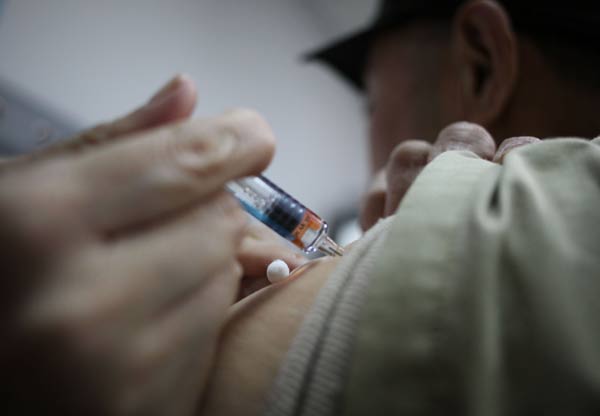 |
| A patient gets a flu shot in Beijing in October. Researchers suggest scheduling shots according to climate zone. WANG JING / CHINA DAILY |
As China prepares to launch a new influenza vaccination program, findings by Chinese and American scientists suggest a staggered program is necessary for the three different climate regions across the country.
A study by researchers from the Chinese Center for Disease Control and Prevention and members of the National Institutes of Health Fogarty International Center in the US collected data from 88 cities over seven years found that flu activity in northern China spikes during the winter, while southern China experiences a peak in the summer.
The mid-region of China, which includes Shanghai, experiences spikes in February and May.
As a result, the one-size-fits-all vaccination programs utilized by most countries would be less effective in China, according to Cecile Viboud, a researcher at NIH and co-author of the report. China should instead schedule vaccination shipments beginning in October for northern regions, and in February for southern regions. The mid-region of China should anticipate two spikes and plan accordingly.
The country currently does not have a national vaccination program, although a vaccine is available for purchase privately and through local government programs in Beijing and a few other cities.
"The climatic differences require very different immunization strategies," Viboud said.
"Many countries assume that because they are in the northern or southern hemisphere, they can go by the standard suggestions for other countries, but this is not true in China."
No other country uses a staggered vaccination program, but the findings of the report also reflect conditions in Brazil, which spans several different climate zones.
Around 2 percent of people in China receive a flu shot each year, while around 30 percent of Americans receive one, the study found.
Government estimates put the annual death rate from flu at around 11 to 18 per 100,000 people in China, with death rates in rural areas about two to three times higher than those in urban areas, Viboud said.
Although China has climate variability, population mobility can also affect the way in which flu epidemics develop, Viboud said.
She noted that Hong Kong and Shenzhen — neighboring cities in southern China — experienced notably different rates of flu incidence before travel restrictions were lifted between the two cities, indicating that the movement of people can spread disease more than climate alone.
The collaboration between NIH and China CDC researchers suggests that the Chinese government will factor the findings of the report into a new nationwide flu vaccination program, expected to be implemented in the coming years, Viboud said. More broadly, the study might also be useful in underscoring the importance of localized health data.
"As routine immunization campaigns are rolled out and local vaccine production improves in resource-limited regions, it will become increasingly important to ensure that vaccination strategies are optimally tailored to the local epidemiology of the disease," the report said.
 Heavy cargo flights taking off
Heavy cargo flights taking off In pictures: PLA's digital equipment
In pictures: PLA's digital equipment  Americans mark Thanksgiving Day with parades
Americans mark Thanksgiving Day with parades Self-made farmer billionaire donates 69 villas at hometown
Self-made farmer billionaire donates 69 villas at hometown Demolition of bizarre rooftop villa in Beijing still in progress
Demolition of bizarre rooftop villa in Beijing still in progress Service seminar for E China train attendants
Service seminar for E China train attendants  China's first nude photographer
China's first nude photographer Selected sports photos of the week
Selected sports photos of the week Treasure of Chinese culture- Nuo Dance
Treasure of Chinese culture- Nuo Dance  Youths in Night club: photo story
Youths in Night club: photo story Models dazzle at Int'l Yacht Model Pageant
Models dazzle at Int'l Yacht Model Pageant  Crystal scenery in China: Jilin fog glaze
Crystal scenery in China: Jilin fog glaze  Tianjin holds first pole dance championship
Tianjin holds first pole dance championship  Annual Santa Claus parade held in Canada's Montreal
Annual Santa Claus parade held in Canada's Montreal China's aircraft carrier passes through Taiwan Strait
China's aircraft carrier passes through Taiwan StraitDay|Week|Month